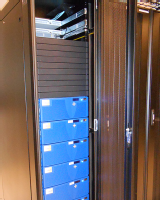UTS Storage Update
June 14, 2013

2012 was a very busy year for the storage team and, as a result, many of the systems administrators and even some of our customers. We took an aging 2-tier infrastructure of datacenter storage and replaced it with a 3-tier infrastructure that is not only substantially less expensive, but also hopefully more versatile:
NAS / Archive: Many of you know this as the Isilon. It is Network Attached Storage (NAS) that can be presented as either NFS or CIFS shares to Windows, Linux, and Mac systems. This is the most economic type of storage to many not only because of the lower acquisition price that is passed along, but also because it is available from anywhere on campus via standard network connectivity and doesn't need the added expense of fibre-channel host bus adapters installed in customers servers. It also has the benefit of being "shared" storage accessible by many systems or users at once and is valuable both for collaboration and workflow in multi-tiered application environments with many servers accessing the same share.
Standard: Our middle tier is currently an EMC VNX platform that incorporates multiple drive technologies (SATA, SAS, and EFD) for very respectable performance at a reasonable price. This is primarily used as storage for servers in the datacenters that are connected via a fiber-optic SAN (Storage Area Network) but is also available as a higher performance NAS option over the Isilon.
Performance: As with our previous architecture, we have a higher-performance option that is currently provided by an EMC Symmetrix VMax class of storage arrays. These tend to be used more for our high-performance PeopleSoft and Oracle environments and are typically used by datacenter servers connected to the SAN. This tier also gives us the ability to do synchronous (real-time) mirroring of this production data to our secondary datacenter and can perform near-instantaneous array-level backup, restore, or even the cloning of data at the storage level with no impact to running applications. We use this functionality not only for disaster recovery and business continuity, but also for periodic data refresh scenarios that get more difficult to do at the application level as the amount of data increases.
Finally, one of our main objectives of this refresh was also to build out environments in both of our datacenters with very similar capabilities. This gives us options to meet future offsite requirements with little to no additional time or money spent in preparation. We already have a mirror of our primary storage capability in our secondary site.
Backup Environment
There have been a lot of things accomplished over the last year that may not be visible to most folks:
- Enterprise TSM (Tivoli Storage Manager) has been upgraded to a 6.x version, which has helped stabilize the TSM environment greatly.
- A second DataDomain backup target has been installed at White Street and is in use both for the UTS TSM environment, but also for a number of customers using it to backup directly to "offsite."
- TSM has been moved to new server hardware and is being configured in a 2-datacenter DR/BC configuration.
Maybe even more interesting are some things we're working on now:
- Evaluating new tools and architectures to protect the growing VM environment. This includes looking at options for the hosted VM offerning.
- Evaluating new options for unlimited cloud backup for desktops, laptops, and mobile devices.
Even though we continue to be busy, I'm always interested in hearing from folks out there who are either using our services or have a particular challenge and are interested in working with us on a solution.
- David Hauenstein, Manager, Infrastructure
University Service Desk at 404-727-7777, Monday - Friday 7 am - 6 pm.
